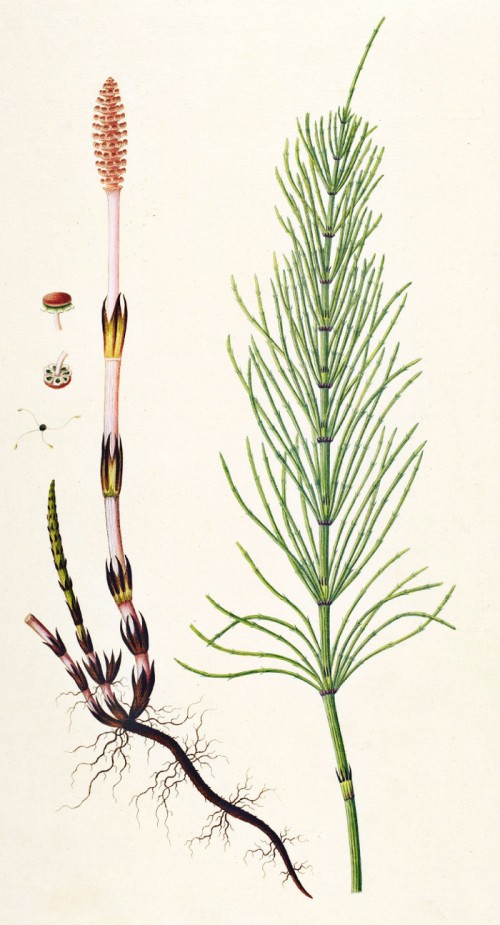Dies ist eine alte Version des Dokuments!
Equisetum arvense L. - Equisetaceae - common horsetail, field horsetail, Ackerschachtelhalm
Perennial herb, up to 50cm high, native to the northern hemisphere.
The dried stems (Equiseti herba) are used mainly as diuretic to treat inflammation of the lower urinary tract, kidney gravel, as well as post-traumatic and static oedema. Traditionally also for slow healing wounds. The herb should not be confused with Equisetum palustre, which contains the enzyme thiaminase that causes poisoning (sometimes fatal to horses and other lifestock).
[Medicinal Plants of the World. Ben-Erik Van Wyk and Michael Wink, Pretoria 2004, 136]
Extracts of E.arvense decreased significantly blood sugar levels in streptozotocin-induced diabetic rats, clearly lending support for its traditional usage.
[Antidiabetic effect of Equisetum arvense L.(Equisetaceae) in streptozotocin-induced diabetes in male rats., Safiyeh, S., Fathallah, F.B., Vahid, N., Hossine, N., Habib, S.S., Pakistan journal of biological sciences: PJBS, 10(10), 2007, 1661] http://docsdrive.com/pdfs/ansinet/pjbs/2007/1661-1666.pdf
„Whilst it acts as a mild diuretic, its toning and astringent action make it of value in the treatment of incontinence and bed-wetting in children. As a diuretic it is particularly suited to metabolic or hormonal oedema during the menopause. It possesses a great capacity to eliminate water from the body; in such a point to
increase urination up to 30% more than what is habitual. This fact makes that its scientific name Equisetum arvense generally appears in the composition of most of products that habitually are sold to reduce weight.“
[Equisetum arvense: pharmacology and phytochemistry–a review., Sandhu, N.S., Kaur, S., Chopra, D., Asian J Pharm Clin Res, 3(3), 2010, 146-150] http://www.ajpcr.com/Vol3Issue3/3.pdf
„T cell proliferation was inhibited dose dependently by the Equisetum extract without induction of apoptosis or
necrosis. This effect was mediated through inhibition of lymphocyte activation, specifically by diminishing CD69 and IL-2 surface receptor expression and intracellular IL-2 production. Furthermore, treatment with Equisetum arvense inhibited effector functions, as indicated by reduced production of IFN-γ and TNF-α…
The data indicate that the used extract of Equisetum arvense interferes with the polyfunctionality of immunocompetent cells thereby providing an anti-inflammatory mode-of-action.“
[Equisetum arvense (common horsetail) modulates the function of inflammatory immunocompetent cells., Gründemann, C., Lengen, K., Sauer, B., Garcia-Käufer, M., Zehl, M., Huber, R., BMC complementary and alternative medicine, 14(1), 2014, 283] http://www.biomedcentral.com/content/pdf/1472-6882-14-283.pdf

Flora Danica [G.C.Oeder et al], fasicle 34, t.2001 (1761-1883)
http://plantgenera.org/species.php?id_species=390684
